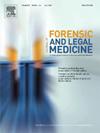利用高分辨率多层计算机断层扫描评估中颅窝孔性别二型性:一项横断面研究
IF 1.2
4区 医学
Q3 MEDICINE, LEGAL
引用次数: 0
摘要
性别估计是法医学的一个主要问题。虽然很少有研究调查中颅窝的两性二态现象,但所获得的结果仍然不一致。方法采用高分辨率128多层三维计算机断层扫描(3D)对3个椎间孔[卵圆孔、圆孔和棘孔]的两性异形进行横断面研究。240名成年埃及人(55.4%为女性,44.6%为男性)被纳入研究,男女比例为1.2,平均年龄为42岁。87年(10.82年)。所有调查的病例均为工业和农业工人,无创伤史或影响中颅窝的病理状况。结果左侧测量值明显大于左侧。埃及男性的卵圆孔的前后尺寸以及中线与左卵圆孔之间的距离明显更高(p <;0.001)/右棘孔(p = 0.018)。所提出的预测性别的模型具有较高的曲线下面积(0.819),敏感性为80.37%,特异性为70.68%。此外,在实际概率和预测概率之间发现了实质性的相关性,表明校准良好。本研究为估计埃及人口性别提供了一种极好的非侵入性替代方法,填补了法医人类学的一个关键空白。获得这种客观的形态测量也有助于在各种外科领域的诊断和治疗的安全临床实践,强调了性别差异背景下解剖变异的重要性。本文章由计算机程序翻译,如有差异,请以英文原文为准。
Evaluation of sexual dimorphism in the foramina of the middle cranial fossa using high-resolution multi-slice computed tomography scan: A cross-sectional study
Introduction
Sex estimation is a primary concern in forensic medicine. Although few studies have investigated sexual dimorphism in the middle cranial fossa, the obtained findings are still inconsistent.
Methods
A cross-sectional study was conducted to investigate the sexual dimorphism in three foramina [foramen ovale, foramen rotundum, and foramen spinosum] using a high-resolution 128 multi-slice three-dimensional (3D) computerized tomography scanner. Two hundred and forty adult Egyptians (55.4 % females and 44.6 % males) were included with a female: male ratio 1.2 and a mean age of 42. 87 (10.82) years. All investigated cases were industrial and agricultural workers with no history of traumatic or pathological conditions affecting their middle cranial fossa.
Results
The obtained measurements were significantly greater on the left side. The Egyptian males displayed significantly higher anteroposterior dimensions of the foramen ovale, as well as the distance between the midline and the left foramen ovale (p < 0.001)/the right foramen spinosum (p = 0.018). A proposed model for predicting sex exhibited a high area under the curve (0.819), a sensitivity of 80.37 %, and a specificity of 70.68 %. Furthermore, a substantial correlation was found between the actual and predicted probabilities, indicating good calibration.
Conclusions
This study offers an excellent non-invasive alternative to other unavailable skeletal measurements for estimating sex among Egyptian populations, filling a critical gap in forensic anthropology. Obtaining such objective morphometric measurements also contributes to safe clinical practice in diagnosis and treatment in various surgical fields, emphasizing the importance of anatomical variations in the context of sex differences.
求助全文
通过发布文献求助,成功后即可免费获取论文全文。
去求助
来源期刊

Journal of forensic and legal medicine
MEDICINE, LEGAL-
CiteScore
2.70
自引率
6.70%
发文量
106
审稿时长
57 days
期刊介绍:
The Journal of Forensic and Legal Medicine publishes topical articles on aspects of forensic and legal medicine. Specifically the Journal supports research that explores the medical principles of care and forensic assessment of individuals, whether adult or child, in contact with the judicial system. It is a fully peer-review hybrid journal with a broad international perspective.
The Journal accepts submissions of original research, review articles, and pertinent case studies, editorials, and commentaries in relevant areas of Forensic and Legal Medicine, Context of Practice, and Education and Training.
The Journal adheres to strict publication ethical guidelines, and actively supports a culture of inclusive and representative publication.
 求助内容:
求助内容: 应助结果提醒方式:
应助结果提醒方式:


